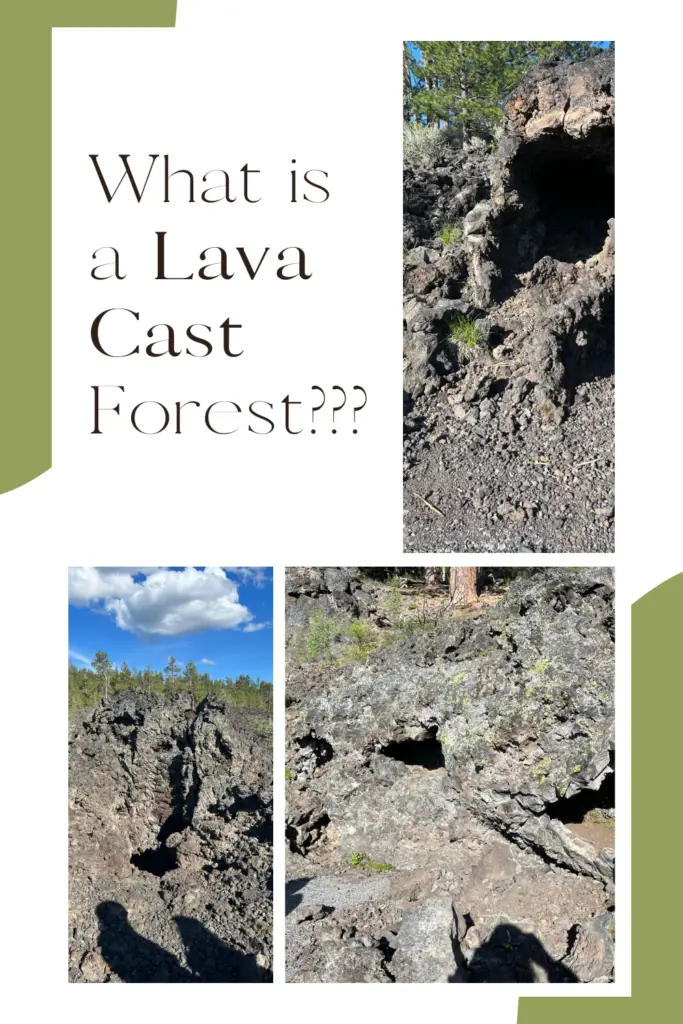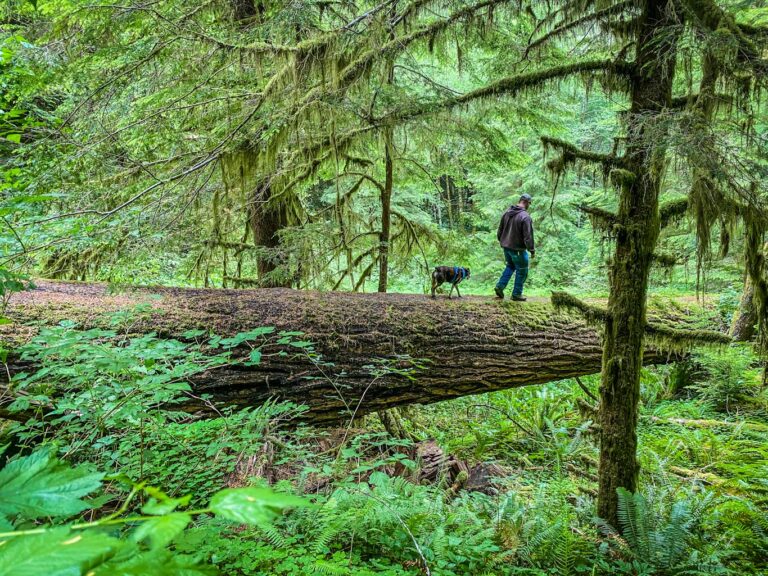Last Updated: Oct. 29, 2024
Even as you’re descending into the giant maw of Lava River Cave near Bend Oregon, you’re thinking the usual thoughts that accompany steps into the subterranean. Will I see stalactites or Stalagmites? Will the floor be slippery with dropping moisture, will sudden bursts of illumination highlight spectacular displays of geologic history (thanks to thoughtful park workers who installed lighting)?
If you paid attention to the mandatory briefing all visitors to Oregon’s Lava River Cave are asked to attend, you know the answer to these questions is a resounding “no”. And if you heard only the first part of the park ranger’s spiel, you know that this gaping subterranean cavern isn’t really a cave at all, despite its name to the contrary.
Lave River Cave near Bend is actually a lava tube, and though it may act in many ways like its namesake, you won’t find most of the expected sites and wonders as you descend into the deep. What similarities you will find lie in total stillness and complete darkness, always permeated by the threat of a bat flying silently above your head.
Table of Contents
Entering Lava River Cave Oregon

We arrived at Lava River Cave in Oregon about 5 minutes before opening and waited at the gate, behind a truck and a mini van, for rangers to let us in. Our early arrival put us in line for the first ranger briefing of the day and allowed us to be among the first guests to rent our $5 “lanterns”, high powered flashlights by my estimation.
Then it was time to head down.
Our first steps into the mouth of Oregon’s Lava River Cave in Oregon were aided by a set of 55 stairs, but that is only the beginning. A series of boardwalks and a total of 155 metal steps traverse a boulder strewn entrance, leading to the floor of Lave River Cave. Yes, it’s a long way down.
While temperatures were in the 60s in early June as we left the sunlight behind, the air rushing from the floor of the lava tube was much cooler. According to the park ranger who offered our early morning briefing, average temperatures below ground remain in the 40s throughout the year.
He also warned us about other things, such as uneven ground and the possibility of seeing bats. Bats are rather revered in this part of Oregon, something as a New Englander, I understand.
Bats help control mosquito populations. A Brown Bat can eat up to 1,000 mosquitos a year. It’s a dedicated service we in the northeast laud and appreciate. In Bend’s Lava River Cave, bats are protected for another reason.
Oregon is one of the few states where White Nose Syndrome hasn’t yet traveled. This dreaded killer has taken the lives of nearly 7 million bats in North America, according to the Center for Biological Diversity, so rangers at Lava River Cave take precautions. You’ll be asked if you’ve been in any caves recently and if so, requested to wear different clothing and shoes. You’ll also be asked to not take any items into Lava River Cave that have been in other underground caverns—this includes cameras and cell phones.
Despite the list of subtle “don’t’s”, there is one “do” that rangers strongly stress. You’ll need a flashlight. No, your little iPhone light won’t cut it. The darkness in a lava tube is deep and unforgiving. Without enough light, you could stumble around for days waiting to be rescued.
Ok, maybe that’s an exaggeration. In reality, groups come through quite often. Since we were some of the first guests to enter the lava tube when we visited, we traveled alone for much of the 1 mile distance, occasionally catching up to or being surpassed by others.
As we left, however, there were numerous groups passing us in the narrow hallway of the lava tube, so fears of abandonment can realistically be set aside.
The need for a light, though, that’s the warning you’ll want to heed. We saw a number of travelers trying to make their way through, depending on a flashlight from the person ahead of them. Worse were those people who ignored the ranger warnings and descended into the deep with their trusty phone light to guide the way. It was a pathetic sight watching these poor souls stumble around without enough illumination to find the bumps in the floor.
It’s a simple word to the wise. Rent the $5 flashlights.

Walking through Lava River Cave Near Bend Oregon
After descending through the series of stairs and boardwalks, we hit a sandy bottom. It was perplexing at first. How did sand come to cover the floor of a tube made from lava? We found out soon enough when a well-placed plaque explained that cracks in the celling of the tube allowed sediment to wash in as rain seeped through the ground.

We also came to understand something our ranger said during our briefing. The Lava River Cave tube is a lava tube inside a tube. Yes, you read that right. Something that is a scientific impossibility (at least according to our park ranger), actually exists beneath the ground in central Oregon.
To understand the tube inside a tube concept, it helps to learn how lava tubes are formed. Imagine a river of hot flowing lava digging through the surface of the earth. According to the National Parks Service, these flows eventually cool, and as they do, the top of the lava flow drops in temperature first.
This means the top hardens, while interior lava continues to flow underneath. Eventually, the sides and bottom of the lava river form a solid surface and the flow completely drains, leaving behind a hollow tube of molten hardened lava.

The tube inside a tube, readily seen about midway into our cavern journey, most likely formed as new lava carved its way around the existing tube. Eventually, part of the original tube’s ceiling was eaten away, leaving a glimpse into the second tube where it surrounds the first. At least that was our supposition.
Lava River Cave Oregon is not the only lava tube cave in the U.S. You can find them in other areas of the country where volcanic activity was prominent, such as California and Arizona.
Lava River Cave near Bend, Oregon, however, has the distinction of being the longest known intact tube, heading northwesterly for about 6,000 feet at a gradual downhill slope. In reality, the descent is so gradual that you won’t realize you’re heading deeper into the earth.
This may be a good thing for some visitors. Even if Oregon’s Lava River Cave isn’t really a cave, it has all the thrills and chills of one, including deadened silence, punctuated by other worldly voices echoing from beyond in the dark.

Visually speaking, it’s hard to describe the tube. At times, our light cast upon smooth walls marred by deep running cracks. At other times, the surface was bumpy, as you’d imagine flowing lava would harden. The floor of the cave while flat and smooth at most places, was also dotted with boulders, and in certain areas, left an uneven walking surface.
Perhaps a third of the way in from the entrance, we found a peculiar phenomenon. The Sand Garden, is an area where sand and water have seeped through the tube’s surface, sculpting small spires and pinnacles. A plaque hung from a chain link fence around the garden informed us that this area of Lava River Cave (Oregon) was often referred to as the “mini Badlands”, an appropriate nickname given the upheaval of the landscape.
Finally, we’d walked a mile and found ourselves facing a warning sign. “Stop,” it said, so stop we did.
This is the end of the road for visitors to this lava tube cave. While Lava River Cave (Oregon) eventually slopes another mile uphill to a separate exit, the floor beyond this point is boulder strewn with no trail to follow. For the sake of safety, the Forest Service restricts access to only the first mile of the tube.

However, it’s a long enough journey to see what life is like underground and ample time to explore the geology of a lava tube.
Things to Know When Visiting Lava River Cave

Lava River Cave in Oregon is part of the broader Newberry National Volcanic Monument. It’s worth spending some time here after visiting the cave, to walk the lava flows and learn more about the history of the state’s tumultuous history. You’ll also find some pretty incredible views of nearby Mount Bachelor and have the opportunity to ascend to the top of an extinct cone.
When Is Lava River Cave (Oregon) Open?
Lava River Cave is open May 5 through September 15. The tube is closed at all other times of the year to protect the bat populations.
Is Lava River Cave (Bend, Oregon) on a Timed Entry System?
Yes. You’ll need a reservation to access the cave. Guests can reserve a two-hour timeslot online. With nearly 70,000 visitors a year heading out to see the lava tube, a timed entry system is the only way to accommodate all of the cars in the small parking lot.
Be sure to check the National Forest Service website, for up-to-date hours of operation.
Bringing Light to Lava River Cave (Oregon)
You’ll need light to explore the lava tube, and as previously mentioned, a phone flashlight is really not enough. Plan for a high-powered flashlight for each member of your party. You can also rent really nice lights for $5 each at the entrance to the cave.
Plan Your Time at Lava River Cave
The walk through Lava River Cave is one mile one way and a 2-mile round trip journey. We found the walk in to take much longer than the walk out. In total, we spent around 90 minutes inside Lava River Cave. We spent approximately 15 minutes listening to the ranger briefing and renting our flashlights.
Dress Appropriately for the Environment
Summer weather in Bend can be quite warm, but temperatures inside the cave will remain in the 40s. That means the shorts and tank top you’re wearing above ground won’t likely ward off the underground chill.
By the time we’d reached the one-mile turn around point, some of us wished we’d even brought a pair of light gloves. Most people were dressed in long pants with a sweatshirt.
You’ll also want to wear sturdy walking shoes or hiking boots into the cave. Open toed shoes are not recommended due to the number of rocks in the path as well as the chill of the air.


















